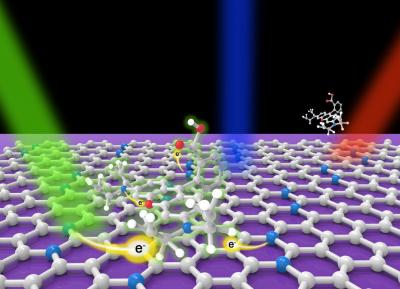An international team of researchers working at Penn State University have developed a highly sensitive chemical sensor using nitrogen-doped graphene as a substrate. This technique can detect trace amounts of molecules in a solution at very low concentrations.
 A model showing the charge transfer (e-) mechanism of Rhodamine B molecules (top) interacting with N-doped graphene (bottom sheet) when excited with different laser lines, which leads to ultrasensitive molecular sensor with N doped graphene.
A model showing the charge transfer (e-) mechanism of Rhodamine B molecules (top) interacting with N-doped graphene (bottom sheet) when excited with different laser lines, which leads to ultrasensitive molecular sensor with N doped graphene.
Raman spectroscopy was used for the development of this sensor, which is a common identification technique used to detect the unique internal vibrations of various molecules: when a laser light irradiates crystals or molecules, it scatters and shifts colors. That scattered light can be detected in the form of a Raman spectrum, which serves as somewhat of a unique fingerprint for every Raman-active irradiated system. Different colors in the visible spectrum will be associated to different energies.
The team chose three types of fluorescent dye molecules for their experiments. Fluorescent dyes, which are frequently used as markers in biological experiments, are particularly hard to detect in Raman spectroscopy because the fluorescence tends to wash out the signal. However, when the dye is added to the graphene or N-doped graphene substrate, the photoluminescence - fluorescence - is quenched. On its own, the Raman signal is so weak that many methods have been used to try to enhance the signal. It was discovered that a technique that uses pristine graphene as a substrate can enhance the Raman signal by several orders of magnitude. The researchers revealed that adding nitrogen atoms to the pristine graphene further enhances sensitivity and gave a theoretical explanation for how graphene and N-doped graphene cause the enhancement.
The explained that "by controlling nitrogen doping we can shift the energy gap of the graphene, and the shift creates a resonance effect that significantly enhances the molecule's vibrational Raman modes". They also noted that "it is hard to quantify the enhancement because it will be different for every material and color of light. But in some cases, we are going from zero to something we can detect for the first time. You can see a lot of features and study a lot of physics then. To me the most important aspect of this work is our understanding of the phenomenon. That will lead to improvements in the technique."
Thanks to graphene's chemical inertness and biocompatibility, the team expects that the new technique will be effective in detecting trace amounts of organic molecules. The researchers are excited about the prospect of combining the technique with available portable Raman spectrometers that can be taken to remote places to detect, for instance, dangerous viruses. The fluorescent dyes they studied will make it fast and easy to see the presence of compounds inside biological cells. The technique itself is simple - dipping the graphene substrate into a solution for a short amount of time - and so it should be feasible to create an entire library of the Raman spectrum of specific molecules.